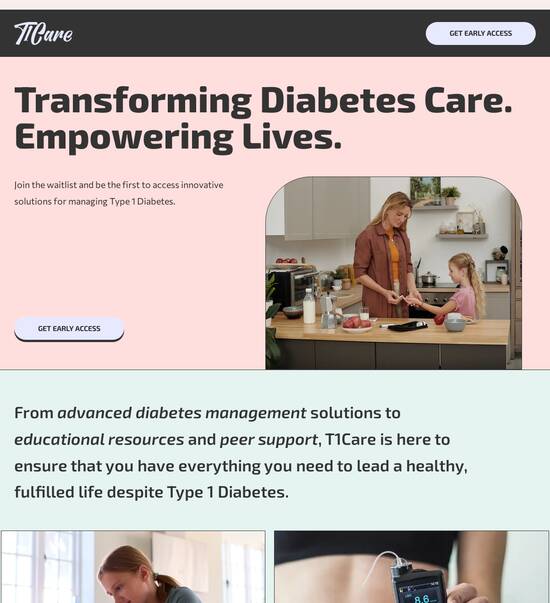
Elegant order history page template
Explore Similar TemplatesAbout template
Unleash your creativity with the elegant order history page template. Try Instapage today.
Recommended templates

Easy to build without coding
With the intuitive drag-and-drop builder, anyone on your team can create high-converting pages without any knowledge of code or design. Make enhancements to your landing page with custom widgets using Javascript, HTML/CSS, or third-party scripts.

Multiple layouts for any industry and goal
Select from 500+ landing page layouts built to boost conversions across industry-specific scenarios. Customize them by adjusting fonts, adding images, and generating on-brand content with the AI assistant. Quickly scale with Instablocks® and Global Blocks that you can save, reuse, and update globally.

Loads fast and looks polished on any device
Every template is responsive, which means they present professionally on any device and load blazingly fast with our Thor Render Engine. You can also power them up with Google AMP technology to deliver an unparalleled mobile experience and drive higher conversions.

Robust analytics & experimentation
Get real-time updates and reporting across all your devices, showing the number of visitors, conversions, cost-per-visitor, and cost-per-lead. Launch AI-powered experiments, run A/B tests, and use heatmaps to analyze user behavior, then optimize your landing page to maximize conversions.







Easy to build without coding
With the intuitive drag-and-drop builder, anyone on your team can create high-converting pages without any knowledge of code or design. Make enhancements to your landing page with custom widgets using Javascript, HTML/CSS, or third-party scripts.
Multiple layouts for any industry and goal
Select from 500+ landing page layouts built to boost conversions across industry-specific scenarios. Customize them by adjusting fonts, adding images, and generating on-brand content with the AI assistant. Quickly scale with Instablocks® and Global Blocks that you can save, reuse, and update globally.
Loads fast and looks polished on any device
Every template is responsive, which means they present professionally on any device and load blazingly fast with our Thor Render Engine.
Robust analytics & experimentation
Get real-time updates and reporting across all your devices, showing the number of visitors, conversions, cost-per-visitor, and cost-per-lead. Launch AI-powered experiments, run A/B tests, and use heatmaps to analyze user behavior, then optimize your landing page to maximize conversions.
All the features you need to build lead-generating landing pages
Explore more featuresLearn how to build top-performing landing pages for any goal
FAQs
Leading the way in building high-performing landing pages





An effective landing page and CRO platform for optimizing your marketing efforts
When it comes to digital marketing, optimizing conversion rates is essential. Instapage is the most powerful landing page and CRO platform that empowers you to create high-converting pages effortlessly, enhancing the performance of your campaigns without the need for coding skills. This guide will take you through the steps to leverage Instapage for maximizing your ROI.
Understanding the importance of landing pages
Landing pages serve a critical role in the customer journey by focusing on a specific campaign or offer. They help in capturing leads effectively and boosting conversions. Here's why landing pages are fundamental to any digital marketing strategy:
- Targeted messaging: Tailor your content to specific audiences for better engagement.
- Conversion-oriented design: Utilize templates designed specifically for high conversion rates.
- Data-driven insights: Use analytics to inform decisions and improve future campaigns.
Step 1: Utilize templates and lead generation elements
To get started with Instapage, choose from over 100 ready-to-use templates that are designed specifically for conversion. Besides, leverage pre-built lead generation elements such as forms, pop-ups, and buttons to enhance your landing pages.
- Easy customization: Modify templates to suit your brand without any coding.
- Pre-built lead elements: Access forms and CTAs that are proven to convert.
- Rapid deployment: Quickly launch campaigns without starting from scratch.
Step 2: Optimize landing pages for conversions
Once your page is set up, it's crucial to optimize it to ensure it delivers results. Use A/B testing to identify what works best for your audience.
- Heatmap analysis: Understand user behavior and optimize placements and content accordingly.
- A/B testing: Experiment with different headlines, CTAs, and layouts to find the most effective combination.
- Performance tracking: Continuously assess metrics to inform future adjustments.
Step 3: Personalize and collaborate for success
Personalization is key in today's marketing landscape. Instapage allows you to create tailored experiences based on user segments. Additionally, facilitate collaboration across your marketing team for faster page creation and feedback.
- Dynamic text replacement: Automatically customize content to match ad campaigns.
- AdMaps: Align ads to landing pages for a cohesive user experience.
- Team collaboration: Provide instant feedback and real-time edits to streamline the production process.
In conclusion, using Instapage directs your marketing efforts more efficiently with tools to optimize and personalize the user experience.
Ready to elevate your digital marketing campaigns? Sign up for Instapage today and start building high-converting landing pages that maximize your ROI.
People also ask about Elegant order history page template
Creating an elegant order history page template for optimal user experience
Understanding the elegant order history page template
An order history page is a crucial component of an e-commerce platform, allowing customers to view their past transactions. This page aids users in tracking their purchases, understanding order statuses, and managing returns or exchanges. A well-designed order history page directly affects a customer’s perception of your brand, enhancing their overall shopping experience and fostering loyalty.
In the competitive world of e-commerce, the significance of a well-crafted order history page cannot be overstated. A user-friendly layout significantly reduces frustration, increases trust, and encourages repeat business. Therefore, focusing on creating an elegant order history page template is not merely an aesthetic choice; it serves a functional purpose that ultimately boosts conversion rates.
Enhanced usability: Helps customers easily navigate through their order details.
Improved customer satisfaction: Quick access to past transactions can alleviate concerns and queries.
Enhanced engagement: Encourages customers to return to the site for further purchases.
Key elements of an elegant design
An elegant order history page should prioritize a clean layout that enhances usability while maintaining aesthetic appeal. This implies employing ample white space, intuitive categorization, and coherent typography. The design should guide users seamlessly from one section to the next without overwhelming them with too much information. Ensuring a responsive design is equally vital; it guarantees that users have a positive experience regardless of the device they choose to use.
Clean layout: A visually appealing design improves user engagement.
Responsive design: Critical for providing consistent experiences on mobile and desktop.
Essential features of an order history page
Feature-rich order history pages shape user experiences significantly. A vital component is delivery processing order tracking, which allows users to monitor their shipment’s journey in real time. Implementing functionalities like shipment notifications and tracking details significantly enhances customer satisfaction and trust in your service. It’s essential to streamline this process, making it easy for users to access the information they need.
Another critical feature is detailed ticket information. Showcasing vital details such as item descriptions, quantities, and prices on order tickets enables customers to review their buying history effectively. Clear information facilitates returns or exchanges, empowering buyers by demonstrating your commitment to transparency.
Delivery processing order tracking: Real-time updates on order status enhance user satisfaction.
Detailed ticket information: Enables users to see all relevant details at a glance.
Rights to return or exchange: Clearly stating policies facilitates ease of returns.
Integration with HR: Streamlines communication for better customer service.
Crafting a user-centric design
User-centric design focuses on intuitive navigation that enhances user engagement. It’s beneficial to categorize orders logically by date or status, allowing users to filter through their transaction history efficiently. The design should cater to user needs, helping them find information quickly and effortlessly.
Personalization plays a vital role in the modern online shopping experience. Integrating features that allow users to see tailored recommendations based on their purchase history elevates user interaction, driving repeat visits to your site. Incorporating data visualization techniques, such as charts or graphs to represent consumer order trends, can also engage users, providing easy-to-understand insights into their spending habits.
Intuitive navigation: Best practices ensure a smooth user experience.
Personalization features: Tailored experiences build customer loyalty.
Data visualization techniques: Graphs and charts simplify complex data.
Enhancing the user experience
In developing your order history page, implementing follow experience follower capabilities proves beneficial. This functionality allows users to track updates and notifications related to their orders seamlessly. Enabling notifications not only keeps customers informed but also enhances their trust in your platform.
Furthermore, accessibility to customer support must be streamlined. Clear pathways for users to access help regarding their orders can prevent frustration. Integrating a support ticketing system directly into the order history page ensures that users have the resources they need to resolve their inquiries swiftly.
Follow experience capabilities: Keeps users updated about their orders.
Streamlined customer support access: Essential for quickly resolving inquiries.
Navigating legal rights and protections
Understanding copyrights and consumer rights is crucial for maintaining compliance and ensuring users feel safe in their transactions. Providing clear information regarding policies on rights to returns and exchanges and ensuring that all customer communications adhere to legal standards is not only responsible but enhances customer trust.
Incorporating robust security measures is essential for protecting order information. Utilizing SSL certificates, adhering to data privacy policies, and employing methods for safeguarding user data from breaches will further enhance customer trust and secure sensitive information.
Understanding copyrights: Essential for legal compliance.
Implementing security measures: Protects user information from potential breaches.
Analytical insights and reporting features
Analyzing customer order trends and patterns is essential for business growth. Through effective tracking of user behavior via order histories, e-commerce businesses can gather insights that guide future service offerings and marketing strategies. Understanding spending habits and popular products can help tailor inventory decisions and improve overall customer satisfaction.
Incorporating feedback mechanisms within the order history page allows customers to share their experiences regarding the products they ordered. This feedback is invaluable for optimizing the order process and contributes to continuous improvement in the user experience.
Customer order trends: Vital for guiding strategic business decisions.
Feedback mechanisms: Improve understanding of customer needs and enhance satisfaction.
Future trends in order history pages
The integration of AI and machine learning into order history pages is poised to reshape e-commerce. These technologies can provide personalized order recommendations and streamline the tracking of buying patterns, making the shopping experience more tailored than ever. Predictive analytics will become a powerful tool for anticipating customer needs effectively.
Furthermore, incorporating social proof and gamification elements can enhance engagement. Showing user ratings and reviews alongside order details can reassure prospective buyers about product quality. Additionally, game-like incentives or rewards for frequent shoppers could encourage more interaction with the order history page.
Integrating AI: Offers personalized recommendations and tracks user behavior.
Incorporating social proof: Enhances buyer trust through user feedback.
Case studies and best practices
Analyzing successful implementations of order history pages in leading e-commerce companies can provide insight into best practices. Reviewing various layouts and functionalities that enhance user experience can inform your design strategy. Learning from companies that faced challenges can also guide improvements in your order history page.
Design tips and tools available can significantly ease the creation of elegant order history pages. Utilizing platforms that offer template designs can accelerate the development process, ensuring that best practices in layout and functionality are adhered to. Professionals should consider aspects such as consistency, clarity, and responsiveness when crafting these pages.
Successful implementations: Highlight effective order history frameworks.
Design tips: Key considerations for creating compelling layouts.
Innovative user engagement strategies
Utilizing email notifications effectively keeps users informed about their order statuses. Establishing templates for tracking updates aids in providing consistent communication, enhancing overall engagement with users. Personalization of these notifications can further increase their effectiveness in retaining customer interest.
Implementing loyalty programs directly through order history pages allows businesses to highlight promotions tied to previous purchases. Incentives for customers to return to their order histories not only re-engages them but can generate repeat business, critical for sustaining growth.
Utilizing email notifications: Keeps users updated about their orders.
Loyalty programs: Engages customers with incentives tailored to their purchase history.
Conclusion and future directions
As e-commerce continues to evolve, so too will the functionalities expected from order history pages. Staying alert to changes in technology and consumer behavior will help businesses adapt to new demands. Anticipated developments such as enhanced integration of AI, ongoing shifts toward personalization, and increased data security will define the future landscape.
In closing, investing in an elegant order history page template is essential for fostering consistent customer satisfaction and engagement. As customer expectations rise, e-commerce platforms must prioritize refining their order history functionalities to ensure a seamless shopping experience.
Ready to skyrocket conversions?
Supercharge your ad campaigns with high-performing landing pages
Get started














